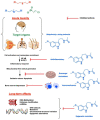Toxicology of Blister Agents: Is Melatonin a Potential Therapeutic Option?
- PMID: 33920224
- PMCID: PMC8167553
- DOI: 10.3390/diseases9020027
Toxicology of Blister Agents: Is Melatonin a Potential Therapeutic Option?
Abstract
Blister or vesicant chemical warfare agents (CWAs) have been widely used in different military conflicts, including World War I and the Iran-Iraq War. However, their mechanism of action is not fully understood. Sulfur and nitrogen mustard exert toxic effects not only through the alkylation of thiol-bearing macromolecules, such as DNA and proteins, but also produce free radicals that can develop direct toxic effects in target organs such as the eyes, skin, and respiratory system. The lack of effective treatments against vesicant CWAs-induced injury makes us consider, in this complex scenario, the use and development of melatonin-based therapeutic strategies. This multifunctional indoleamine could facilitate neutralization of the oxidative stress, modulate the inflammatory response, and prevent the DNA damage, as well as the long-term health consequences mediated by vesicant CWAs-induced epigenetic mechanisms. In this context, it would be essential to develop new galenic formulations for the use of orally and/or topically applied melatonin for the prophylaxis against vesicant CWAs, as well as the development of post-exposure treatments in the near future.
Keywords: DNA damage; galenic formulation; inflammation; melatonin; oxidative stress; safety; sulfur and nitrogen mustard.
Conflict of interest statement
The authors declare no conflict of interest.
Figures






References
-
- Pita R., Anadón A., Romero A., Kuca K. Chapter 7—Chemical Weapons of Mass Destruction and Terrorism: A Threat Analysis. In: Gupta R.C., editor. Handbook of Toxicology of Chemical Warfare Agents. 3rd ed. Academic Press; Boston, MA, USA: 2020. pp. 79–94.
-
- Somani S. Toxicokinetics and Toxicodynamics of Mustard. In: Somani S., editor. Chemical Warfare Agents. Academic Press; San Diego, CA, USA: 1992. pp. 13–50.
-
- Somani S.M., Babu S.R. Toxicodynamics of sulfur mustard. Int. J. Clin. Pharmacol. Ther. Toxicol. 1989;27:419–435. - PubMed
Publication types
Grants and funding
LinkOut - more resources
Full Text Sources
Other Literature Sources

